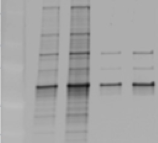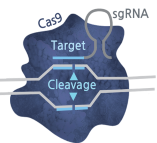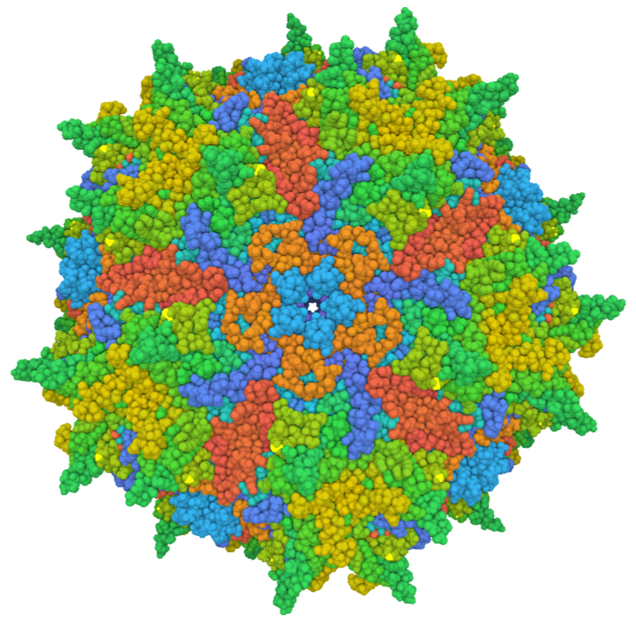AAV Tools

Graham Beards’ Own work CC BY-SA 4.0
Adeno-Associated Virus (AAV) is a small dependoparvovirus which was initially discovered as a contaminant in adenovirus preparations. AAVs are non-enveloped and consist of an icosahedral capsid containing a short, single-stranded DNA genome flanked by two Inverted Terminal Repeat sequences (ITRs).
AAVs are replication-defective, non-pathogenic, and have not been associated with any human disease. Although wild-type AAV can integrate at very low frequencies into the host genome, this integration is predominately into the “safe harbor” site at AAVS1 on the human chromosome 19. Meanwhile, recombinant AAV used in gene therapy has been engineered to be integration-deficient and to deliver a gene of interest (up to ≤5 kb in length) in place of the viral genome. Inside the cell, the recombinant AAV vector is maintained as an episome and can result in sustained expression of the gene of interest for up to 6 months in non-dividing cells. Due to its low immunogenicity and lack of insertional mutagenesis, AAVs are safe for clinical use and are the vector of choice for many gene therapies currently in development. They are also the best vector to transduce a gene of interest to animals.
Adeno-Associated Virus (AAV) is a small dependoparvovirus which was initially discovered as a contaminant in adenovirus preparations. AAVs are non-enveloped and consist of an icosahedral capsid containing a short, single-stranded DNA genome flanked by two Inverted Terminal Repeat sequences (ITRs).
AAVs are replication-defective, non-pathogenic, and have not been associated with any human disease. Although wild-type AAV can integrate at very low frequencies into the host genome, this integration is predominately into the “safe harbor” site at AAVS1 on the human chromosome 19. Meanwhile, recombinant AAV used in gene therapy has been engineered to be integration-deficient and to deliver a gene of interest (up to ≤5 kb in length) in place of the viral genome. Inside the cell, the recombinant AAV vector is maintained as an episome and can result in sustained expression of the gene of interest for up to 6 months in non-dividing cells. Due to its low immunogenicity and lack of insertional mutagenesis, AAVs are safe for clinical use and are the vector of choice for many gene therapies currently in development. They are also the best vector to transduce a gene of interest to animals.
A Specialized Suite of AAV Products
AAV Purification

When injecting AAV particles into animals, it is necessary to use highly purified particles with minimal host cell proteins. The AAV ONE-Extract™ Solution provides a simple and efficient method for particle isolation and is suitable for all AAV serotypes, enabling improved performance over conventional freeze-thaw or sonication methods for isolation from production cells.
Reporter AAVs

Reporter proteins, such as luciferase or fluorescent markers, are ideal to visualize and/or quantify gene expression following AAV transduction. Luciferase, ZsGreen, and mCherry-containing AAVs can be used as internal controls, to optimize transduction and experimental conditions, track transgene expression over time, or monitor AAV behavior and transduction in vivo.
SaCas9 AAVs

AAV SaCas9 vectors transduce HA-tagged SaCas9 (Staphylococcus aureus CRISPR associated protein 9), which has high cutting efficiency in mammalian cells. Its small size makes it ideal for packaging into AAV while the HA tag enables detection of the expressed protein. These vectors are used to express SaCas9 over-expressing cell line and facilitate knock-out or knock-in studies.
AAV Purification

When injecting AAV particles into animals, it is necessary to use highly purified particles with minimal host cell proteins. The AAV ONE-Extract™ Solution provides a simple and efficient method for particle isolation and is suitable for all AAV serotypes, enabling improved performance over conventional freeze-thaw or sonication methods for isolation from production cells.
Reporter AAVs

Reporter proteins, such as luciferase or fluorescent markers, are ideal to visualize and/or quantify gene expression following AAV transduction. Luciferase, ZsGreen, and mCherry-containing AAVs can be used as internal controls, to optimize transduction and experimental conditions, track transgene expression over time, or monitor AAV behavior and transduction in vivo.
SaCas9 AAVs

AAV SaCas9 vectors transduce HA-tagged SaCas9 (Staphylococcus aureus CRISPR associated protein 9), which has high cutting efficiency in mammalian cells. Its small size makes it ideal for packaging into AAV while the HA tag enables detection of the expressed protein. These vectors are used to express SaCas9 over-expressing cell line and facilitate knock-out or knock-in studies.
Custom AAV Solutions
Our AAV team will design your custom AAV constructs and will manufacture ready-for-use viral particles to transduce your gene(s) of interest. Applications include CRISPR-mediated genetic engineering, protein expression, and the design and optimization of AAV-mediated gene transfer using reporter AAVs. Learn more about our custom AAV services.
Tropism of AAV Serotypes

A 3-D rendering of AAV-2 structure derived from PBD ID 1LP3.
To date, 11 AAV serotypes have been isolated from humans and non-human primates. Each of these serotypes shows preferential binding for specific cell types and tissues, as determined by the binding affinity of the capsid proteins to receptors on the cell surface. Thus, scientists can utilize this tropism to efficiently target specific cell types. In addition, several genetically engineered AAV serotypes have been developed to further increase tissue tropism and transduction efficiency for gene therapy purposes. Thus, AAV-DJ has better transduction efficiency in vitro and in vivo compared to wild-type serotypes, and consequently it can infect a broad range of cell types.

Product Results
│AAV Products
- CAR-T Cell Therapy AAVs
- SaCas9 AAVs
- Cell Signaling Pathway AAVs
- Gene and Cell Therapy AAVs
- Neuroscience AAVs
- AAV Purification

